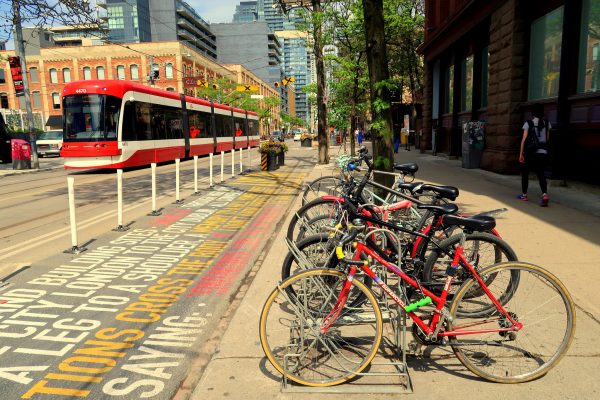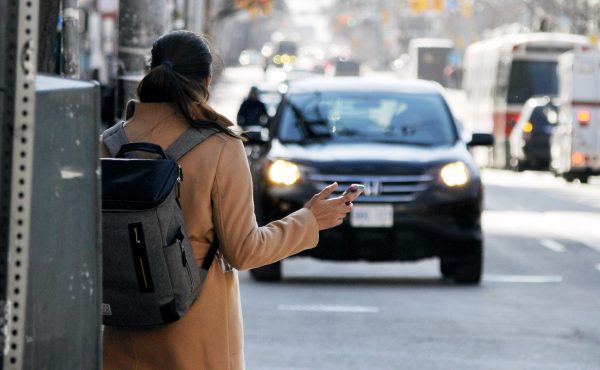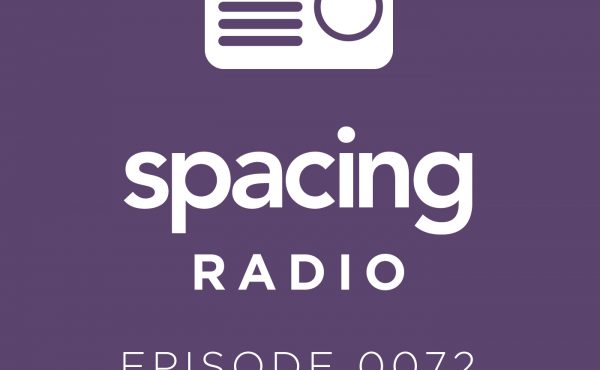This is probably a pointless plea, but can we stop talking about congestion?
Our conversations about transportation in Canadian urban regions these days all centre on “congestion.” The cost! The frustration! The pollution! All bad things, I agree.
But I don’t think congestion is our biggest problem or even the problem it presents itself to be. It frames the city and its issues in ways that may even be counterproductive.
This focus on congestion is especially worrisome when it comes to transit. Transit projects are often justified because they will “reduce” or “solve” congestion.
For example, last September, the BC government announced funding for two transit infrastructure projects under the headline: “Major rapid transit projects to ease congestion in metro Vancouver.
In registering its support for a multimodal hub at Pearson Airport, the Toronto Region Board of Trade listed the reduction of congestion first among anticipated outcomes of the project.
Problem A with this thinking is that transit will not do that. Or, at least, not as much you might hope.
Some consider it the “Fundamental Law of Highway Congestion”: a reduction of traffic congestion by transit or any other measure will eventually be reversed when drivers discover the road has improved.
At best, transit will help you avoid congestion, if you take transit and if that transit is in its own right-of-way. Plus, transit needs to provide sufficient capacity for its ridership or it will experience overcrowding – another form of congestion.
Problem B is that solving congestion is not the point of transit. When we focus on congestion, we forget what transit really accomplishes. Even transit advocates change the way they talk and think about transit.
Transit advocates sometimes call for congestion pricing as an answer to poor transit service. The hope is that the funds raised by congestion pricing will flow to transit agencies for improved systems and service. A further hope is that the cost will deter some drivers and we will have fewer cars on the road, or at least the roads subject to pricing.
(Some places have dirtier air than others, but a car is a car no matter what road it’s on, and there’s only one environment. Reduce the need to drive. Tax all drivers in an urban area. Charge for parking always and everywhere.)
I’m not against congestion pricing in theory, but it’s no silver bullet. And there’s lots of evidence that it’s not essential nor even the most effective way to shift people from driving to transit or active transportation. (See, for example, Seattle and Vancouver, cities that made huge improvements without congestion charges.) While the cost of mobility has some impact on mode choice, it is speed, frequency, reliability, safety, and network and landscape design that have the biggest impact.
My purpose here is not to debate congestion charges, but to question our obsession with congestion, and how it then frames our thoughts about mobility.
City life is interdependent. Everyone regularly has to go somewhere else to meet their daily needs. Mobility is thus essential to the well-being of a city’s residents and economy.
Modes of mass transportation are, first and foremost, efficient. Their efficiency becomes beneficial and often essential when the movement of people and goods is at the scale of a big city.
Its efficiency is also necessary in urban space, which is more compact than suburban or rural landscapes (its compactness is also part of a city’s efficiency). Urban space is also used by a high volume and diversity of users. They use its space simultaneously, but differently. They move by different modes and in different directions.
It is useful at this point to remember how often the same space is used every day by thousands, even hundreds of thousands of people. Urban space must be designed to accommodate this temporary usage and fluid motion.
Mass transportation is necessary to accommodate the geometric limits of city space and its diversity of uses for distances beyond comfortable pedestrian travel. Pedestrian travel includes those escorting children, pushing strollers, using a mobility aid of any kind (wheelchairs, walkers, crutches, white canes, etc.), or carrying goods. This diversity of pedestrians means that “comfortable” distances will vary by person and with the weather. We have to assume that we need mass transit even for what seem like short, walkable distances.
Mass transit is environmentally efficient. One bus has the equivalent CO2 emissions of as many as 10 cars. The operation of electric buses has zero emissions.
Most importantly, mass transit enables economic participation and citizen well-being. This is what we mean when we say things like transit is “the lifeblood” of a city: because it does the most, in the most efficient way, to move people and goods around in a city, and the city cannot survive without it. The circulation of people and goods is necessary to distribute and consume resources in an urban economy. Improved circulation creates opportunities and the ability to access them.
Economic inequality in cities is a bigger problem than congestion, and it’s a problem that transit can genuinely and sustainably help address.
Congestion is a problem we want to make better, but urban roadways in a busy city will always have some. Above all, “solving” congestion is not the most important aspect of transit. Good transit planning isn’t a “fix”; it is an investment in the lives of a city’s residents and in the wealth of the city as a whole. It is always worth the effort to provide good transit governance, funding, planning and service. Without them, a city will not thrive.





5 comments
The only reason you see these projects framed around “reducing congestion” is because it is a smart, if misleading, way to sell urban transit projects to a mostly suburban voter base, which likely won’t stand to benefit directly from them.
Politics is a game of consensus, and most households with two cars in Mississauga couldn’t care less about the light-rail and subway projects in Toronto.
Tricia wrote: “Congestion is a problem we want to make better, but urban roadways in a busy city will always have some.”
Kevin’s comment: That is simply not true. Except for the most dense of Asian cities, making roadways car-free usually has the effect of completely eliminating congestion. For example, consider Vredenburg, the main East-West street in the city of Utrecht. Up to 37,000 people per day travel by bicycle on this street, and there are many more pedestrians and public transit users. And yet, no congestion. Take a look at this video of rush-hour Vredenburg at:
https://bicycledutch.wordpress.com/2017/06/06/the-busiest-cycleway-in-the-netherlands/
I don’t live in Toronto any more but spend as much or more time there as I do at home. Transit takes me nearly 2 hours each way — when everything operates properly. (Driving used to take less time but the exodus from Toronto to the suburbs and hinterland has made a one-way 1.5 hour commute into a three-hour tour if you aren’t out the door by 5 AM as the drivers return to their jobs in the city from their new digs in Newmarket, Aurora, Barrie, Orillia, etc.). I still need to drive once a week, but mostly commute by GO now. But congestion? It extends well beyond the city limits. I don’t especially like paying $13 one way for a packed train ride, but there you go. Transit isn’t that comfy for anybody, I suppose (except that one time I took the UP Express. THAT was nice!). I can’t say if the GO has alleviated congestion or not as there are more cars on the road on the 400 than there were 10 years ago.
There are factors beyond transit that affect congestion.
For one, the average size of a house grew over many decades, with larger garages and driveways accommodating more vehicles per house.
Secondly, the population of vehicles grew faster than the population of people; with many young people living at home longer, they were able to buy vehicles, using the money they would have otherwise spent on their own housing.
Third, the cost of buying, operating and insuring a vehicle, while not as cheap as taking transit, has remained moderate enough for many city dwellers to own vehicles, even if they don’t use them all the time.
And fourth, zoning rules evolved to accommodate vehicular traffic and continue to do so, at the expense of car-free lifestyles.
From outside a growing city like Toronto, it’s easy and common to look in and say, “I’ll move there and live without a personal vehicle,” but for many reasons, once people arrive, many of them tend to get one after all.
I’ve been mulling on this point of talking, or not talking about ‘congestion’ – and I’m not sure we should curtail our mentions of ‘congestion’, but rather use it as a starting point to rebut more than a few of the presumptions/basis of ‘carservative’ thinking, or ideology, (sometimes idiotology’). The SOV’s that clog our carterials and excessways can be easily shown to be the ultimate space hogs and high-consumers of costly and valuable roadspace instead of transit. And that is a way to direct talk to how well the cars are subsidized, which is a LOT of hidden subsidies vs. transit, usually in one budget, and Vancouver found they had 7X more to cars than transit a couple of decades ago.
Also, we can begin to talk about pedestrian congestion, and yes, transit congestion too, and why do we pay soo much for TTC fares when the Gardiner/DVP/401 is free? And that is very much of an equity issue – like the billion or whatever going to the Gardiner, and how much for transit? And do we have any Relief West, like that 1957 plan?